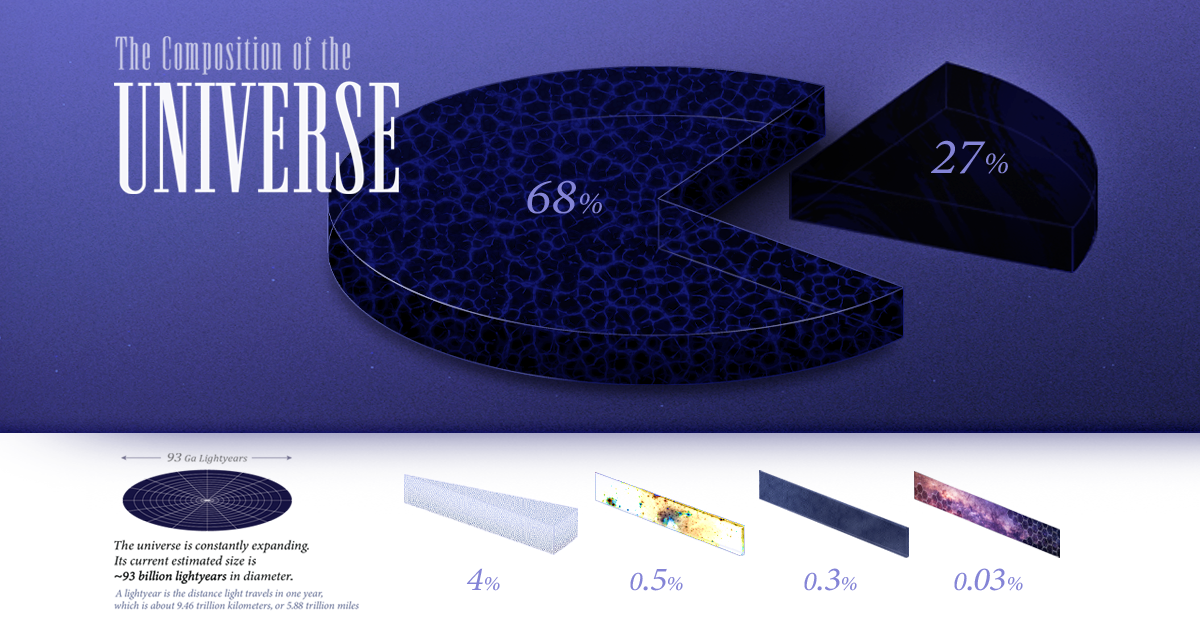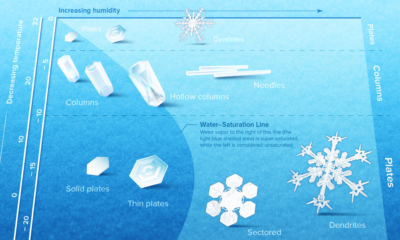Misc
All the Contents of the Universe, in One Graphic
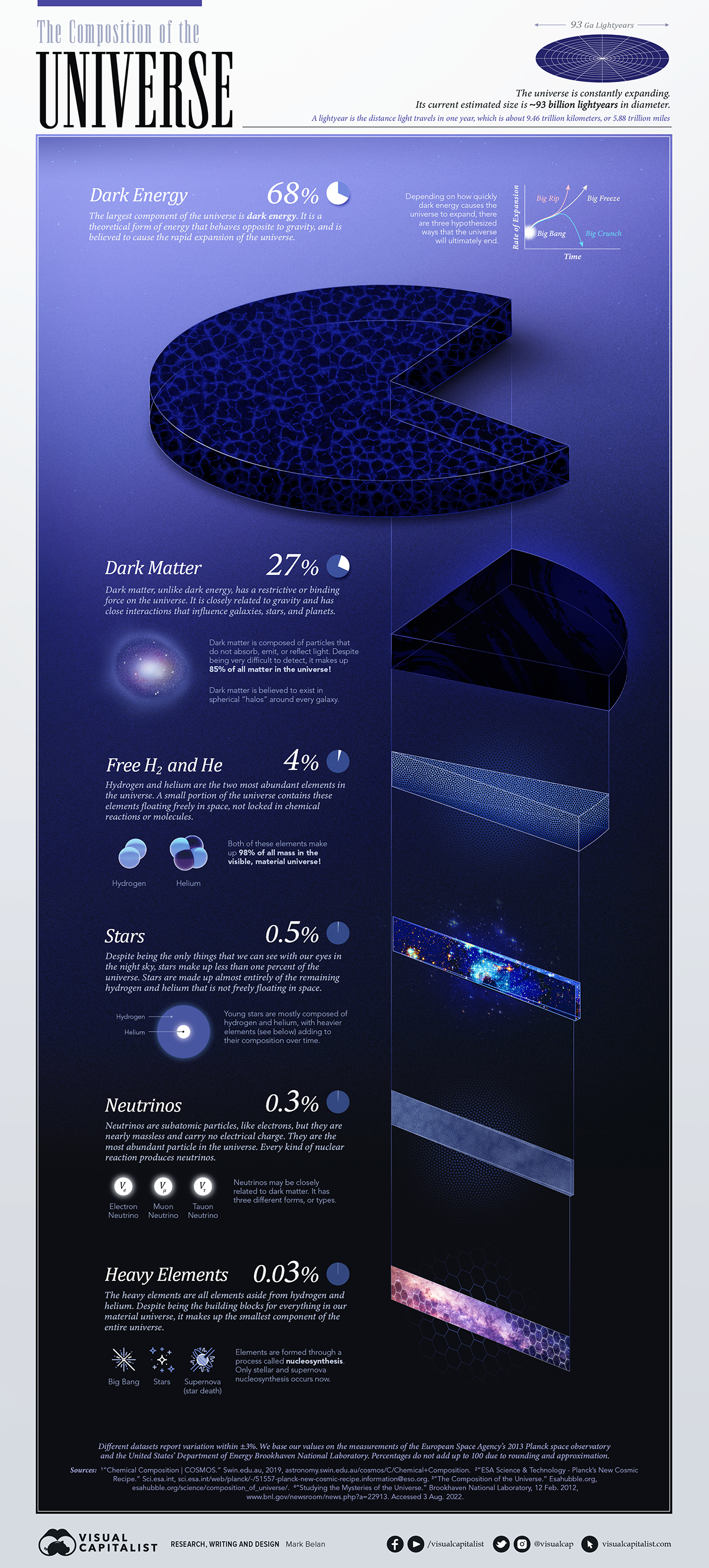
All the Contents of the Universe, in One Graphic
Scientists agree that the universe consists of three distinct parts: everyday visible (or measurable) matter, and two theoretical components called dark matter and dark energy.
These last two are theoretical because they have yet to be directly measured—but even without a full understanding of these mysterious pieces to the puzzle, scientists can infer that the universe’s composition can be broken down as follows:
| Component | Value | ||||
|---|---|---|---|---|---|
| Dark energy | 68% | ||||
| Dark matter | 27% | ||||
| Free hydrogen and helium | 4% | ||||
| Stars | 0.5% | ||||
| Neutrinos | 0.3% | ||||
| Heavy elements | 0.03% |
Let’s look at each component in more detail.
Dark Energy
Dark energy is the theoretical substance that counteracts gravity and causes the rapid expansion of the universe. It is the largest part of the universe’s composition, permeating every corner of the cosmos and dictating how it behaves and how it will eventually end.
Dark Matter
Dark matter, on the other hand, has a restrictive force that works closely alongside gravity. It is a sort of “cosmic cement” responsible for holding the universe together. Despite avoiding direct measurement and remaining a mystery, scientists believe it makes up the second largest component of the universe.
Free Hydrogen and Helium
Free hydrogen and helium are elements that are free-floating in space. Despite being the lightest and most abundant elements in the universe, they make up roughly 4% of its total composition.
Stars, Neutrinos, and Heavy Elements
All other hydrogen and helium particles that are not free-floating in space exist in stars.
Stars are one of the most populous things we can see when we look up at the night sky, but they make up less than one percent—roughly 0.5%—of the cosmos.
Neutrinos are subatomic particles that are similar to electrons, but they are nearly weightless and carry no electrical charge. Although they erupt out of every nuclear reaction, they account for roughly 0.3% of the universe.
Heavy elements are all other elements aside from hydrogen and helium.
Elements form in a process called nucleosynthesis, which takes places within stars throughout their lifetimes and during their explosive deaths. Almost everything we see in our material universe is made up of these heavy elements, yet they make up the smallest portion of the universe: a measly 0.03%.
How Do We Measure the Universe?
In 2009, the European Space Agency (ESA) launched a space observatory called Planck to study the properties of the universe as a whole.
Its main task was to measure the afterglow of the explosive Big Bang that originated the universe 13.8 billion years ago. This afterglow is a special type of radiation called cosmic microwave background radiation (CMBR).
Temperature can tell scientists much about what exists in outer space. When investigating the “microwave sky”, researchers look for fluctuations (called anisotropy) in the temperature of CMBR. Instruments like Planck help reveal the extent of irregularities in CMBR’s temperature, and inform us of different components that make up the universe.
You can see below how the clarity of CMBR changes over time with multiple space missions and more sophisticated instrumentation.
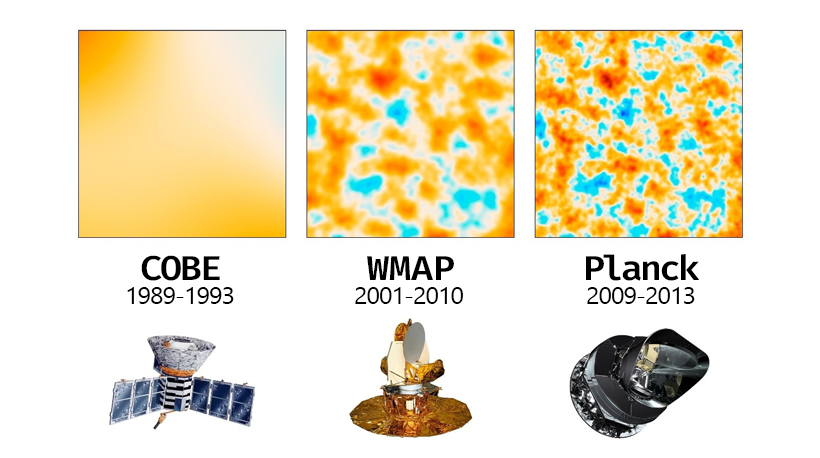
What Else is Out There?
Scientists are still working to understand the properties that make up dark energy and dark matter.
NASA is currently planning a 2027 launch of the Nancy Grace Roman Space Telescope, an infrared telescope that will hopefully help us in measuring the effects of dark energy and dark matter for the first time.
As for what’s beyond the universe? Scientists aren’t sure.
There are hypotheses that there may be a larger “super universe” that contains us, or we may be a part of one “island” universe set apart from other island multiverses. Unfortunately we aren’t able to measure anything that far yet. Unravelling the mysteries of the deep cosmos, at least for now, remains a local endeavor.
China
How Do Chinese Citizens Feel About Other Countries?
What is the Chinese public’s view of world powers? This visual breaks down Chinese sentiment towards other countries.
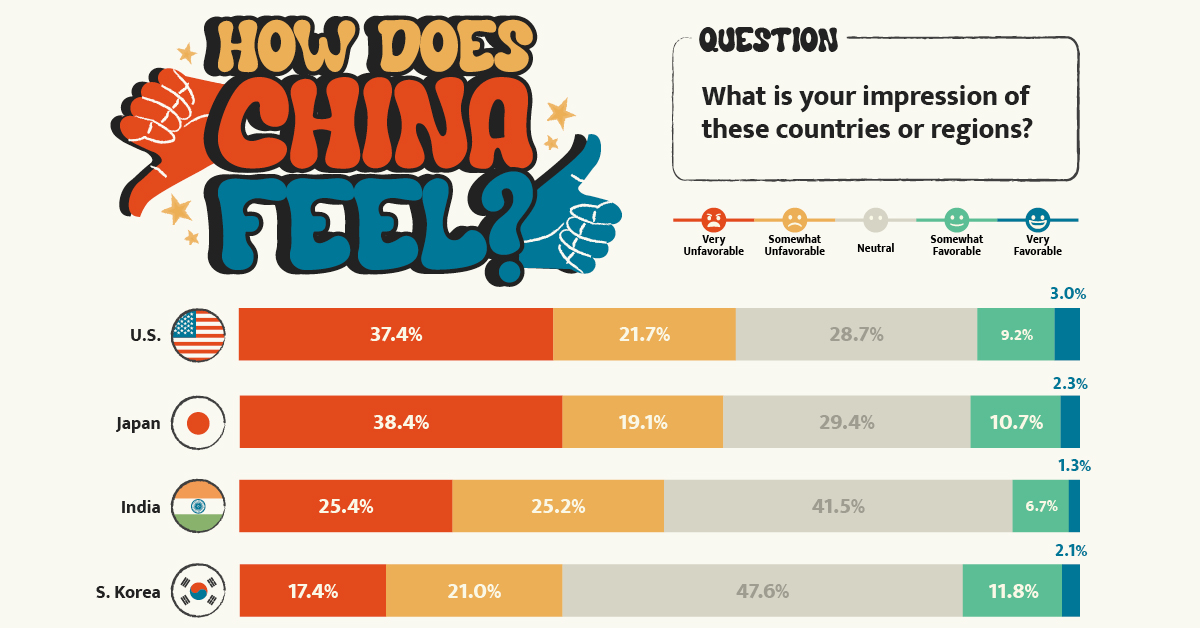
Public Opinion: How Chinese Citizens Feel About Other Countries
Tensions over Taiwan, the COVID-19 pandemic, trade, and the war in Ukraine have impacted Chinese sentiment towards other countries.
This visualization uses data from the Center for International Security and Strategy (CISS) at Tsinghua University to rank survey responses from the Chinese public on their attitudes towards countries and regions around the world.
Chinese Sentiment Towards Other Countries in 2023
In the Center’s opinion polls, which surveyed a random sample of more than 2,500 Chinese mainland adults in November 2022, Russia came out significantly ahead.
Just under 60% of respondents held Russia in a favorable view, with 19% seeing the country as “very favorable.” Contrast that to the mere 12% that viewed the U.S. in a positive light.
Here’s a closer look at the data. The percentages refer to the share of respondents that voted for said category.
| Country/Region | Very Unfavorable | Somewhat Unfavorable | Neutral | Somewhat Favorable | Very Favorable |
|---|---|---|---|---|---|
| 🇺🇸 United States | 37.4% | 21.7% | 28.7% | 9.2% | 3.0% |
| 🇯🇵 Japan | 38.4% | 19.1% | 29.4% | 10.7% | 2.3% |
| 🇮🇳 India | 25.4% | 25.2% | 41.5% | 6.7% | 1.3% |
| 🇰🇷 South Korea | 17.4% | 21.0% | 47.6% | 11.8% | 2.1% |
| 🇪🇺 European Union | 9.3% | 15.6% | 57.6% | 14.1% | 3.3% |
| Southeast Asia | 7.1% | 13.1% | 59.5% | 16.8% | 3.5% |
| 🇷🇺 Russia | 3.0% | 4.8% | 33.7% | 39.4% | 19.0% |
Japan ranked just below the U.S. in terms of overall unfavorability, though a slightly higher share of respondents saw Japan as “very unfavorable” compared to America. This is likely due to both modern tensions in the East China Sea over mutually claimed islands and historical tensions over the Sino-Japanese Wars.
Chinese sentiment towards India was also unfavorable at just over 50%, though notably the country also received the lowest favorability rating at just 8%.
Additional Survey Findings
The survey also found that 39% of Chinese people get their information on international security from Chinese state-run media (mainly through TV), with an additional 19% getting information from government websites and official social accounts. Conversely, only 1.7% get their news from foreign websites and foreign social media, partially due to the Great Firewall.
When asked about different international security issues, the biggest shares of Chinese citizens ranked the following as their top three:
- Pandemics (12.9%)
- Disputes over territory and territorial waters (12.9%)
- China-U.S. relations (12.0%)
The pandemic’s high score reflects the harsher impact COVID-19 had on China. Chinese borders were shut for years and the public faced intense measures to reduce spread.
In terms of other world events, the majority of Chinese people align with a more “Eastern” viewpoint. For example, in regards to the war in Ukraine, the report found that:
“About 80 percent of the respondents believe the U.S. and Western countries should be held most accountable [for the war], while less than ten percent of the respondents argue that Russia is mainly responsible.”– Center for International Security and Strategy, Tsinghua University
Overall, the views of the Chinese public reflect the opposite of those found in many Western countries. They provide an important insight that it is not just the Chinese government holding particular views about the world, but the Chinese public as well.
-

 Green5 days ago
Green5 days agoHotter Than Ever: 2023 Sets New Global Temperature Records
-

 Datastream4 weeks ago
Datastream4 weeks agoCan You Calculate Your Daily Carbon Footprint?
-

 Energy2 weeks ago
Energy2 weeks agoWho’s Still Buying Russian Fossil Fuels in 2023?
-

 VC+4 days ago
VC+4 days agoWhat’s New on VC+ in July
-

 Investor Education4 weeks ago
Investor Education4 weeks agoVisualizing BlackRock’s Top Equity Holdings
-

 Technology2 weeks ago
Technology2 weeks agoMeet the Competing Apps Battling for Twitter’s Market Share
-

 China14 hours ago
China14 hours agoHow Do Chinese Citizens Feel About Other Countries?
-

 Markets4 weeks ago
Markets4 weeks agoVisualizing Every Company on the S&P 500 Index




